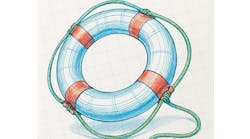We conclude this series with a look at how to tune a controller when the objective is to maximize the absorption of variability rather than tight control of the process variable. The details for the most common case of surge tank level control are provided. Many plants have excessively variability that can be traced to inappropriate level controller tuning. Simple relationships show how tuning settings can be computed.
The control literature is focused on tight control of the process variable and more specifically minimizing the integrated error for load disturbances and/or getting to setpoint faster. These objectives can be the exact opposite of what needs to be done when this maximizing of the transfer of variability to a manipulated flow upsets other loops or downstream systems.
Process volumes offer the possibility of absorbing process variability. The absorption potential is proportional to the residence time (volume to feed flow ratio). This principle is used extensively in pH control to attenuate (filter) inline system oscillations by the use of downstream volumes. For the moderation of composition, pH, and temperature variability, it is desirable for the volume to be back mixed. For perfect mixing, the entire residence time can be considered a filter time constant for smoothing variability. If the downstream volumes are waste treatment tanks or product blend and storage tanks, there is minimal if any control on the tank and the volume simply acts to absorb variability. These volumes all have a near or true integrating response.
When level is controlled in upstream volumes by the manipulation of a discharge flow feeding downstream unit operations, tight level control will maximize the feed disturbances to these operations. Feed upsets tend to be particularly disruptive because the disturbance is very fast. If tight level control is not needed for recycle or residence time control, the objective is to maximize the absorption of level changes. The classic case is surge tank level. Another case is overhead distillate receiver level for a column when the level controller is manipulating distillate flow that could potentially upset additional downstream separation and purification operations. Note if the distillate receiver manipulates reflux back to the column, we have effectively a recycle level system and tight level control is beneficial for providing internal reflux control. In plant wide control systems, tight recycle receiver level control is essential for reactor composition control.
As mentioned last week lambda integrator tuning rules are used for near integrating, true integrating, and runaway processes. Here lambda is an arrest time, which is the time for the process variable to reach its peak and start its return to setpoint for a load disturbance. In slides 125-127 of the short course I taught on March 7, 2013 for the ISA New Orleans section titled "Effective Use of PID Controllers" equations are developed to maximize the arrest time to maximize the absorption of variability. The generic version is developed to show how the arrest time depends upon the allowable change in the process variable and the available change in the manipulated variable (controller output). The equations are then detailed for the most common example of maximizing the absorption of variability for level control. If lambda tuning is then used, the user will not get into trouble by violating the rule that the product of the controller gain and reset time be greater than twice the inverse of the integrating process gain (slide 103).
As a postscript, a simple translation of the process variable can create a steady state. The process variable is passed through a dead time block (with its parameter set equal to the total loop dead time) to create an old PV. If the old PV is subtracted from the new PV and divided by the loop dead time, the resulting PV rate of change will show a steady state after any secondary lag for slow near- integrating, true integrating, and runaway processes. For slow near-integrating and runaway processes the PV rate of change will decelerate and accelerate, respectively but this is negligible in the PID time frame. This technique is useful for batch process analysis and control.




